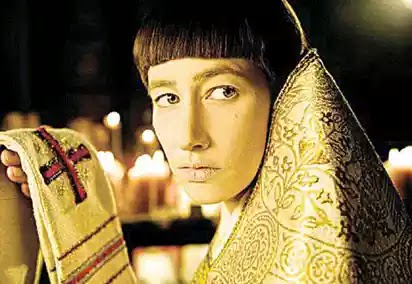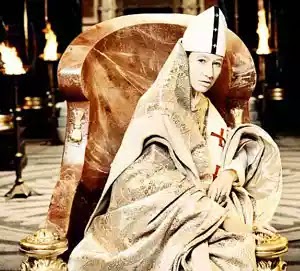….New film reopens one of Vatican’s most enduring wounds
By Peter Stanford
For centuries, the Roman Catholic Church has tried to bury her story.
But of all the legends suppressed by the Vatican over the years, this is one that refuses to go away. Now, a new film has brought to life the story of the only female pope – and it is being shown this week in cinemas cheek by jowl with the Vatican. And there are plans to bring it to Britain.
For a church that still treats women as second-class citizens, it is a source of considerable embarrassment and will once again raise the question of whether Pope Joan, as she is called in medieval chronicles, really did exist.
The Vatican claims that she was a mythical figure used by early Protestants to discredit and embarrass Rome.
But the film – which stars John Goodman from Roseanne, David Wenham, last seen with Nicole Kidman in Australia, West End regular Iain Glen and, in the title role, German actress Johanna Wokalek – is billed as ‘a true story’.
And it is a pretty extraordinary story: a woman of devout faith disguises herself as a man to become a priest and is then elected pope.
Only when she gives birth in the street while in a procession in full papal regalia is her true identity revealed – after which, inevitably, she meets a grisly end. What is more, the legend has it that she was English.
Catholics have long been told there has only been one English pope – Adrian IV in the 1150s. But according to many medieval chronicles, John Anglicus – John the English – reigned from AD855 for two years, seven months and four days before the astonishing revelation that he was, in fact, a she called Joan.
Many of the medieval Books Of Popes, the principal source for the history of the papacy during the Dark Ages, record the tale of a young girl born of English missionary parents.
Raised in Germany at Fulda – the final resting place of St Boniface, who had travelled there from his native Devon to convert pagans – it is said she was clever and spent all her time in the libraries Boniface had established.
They stoned the treacherous mother and child to death When she was 12, she was told she could not continue her studies alongside the boys in her class, but had to marry and have children.
She refused and, donning a monk’s cowl and ankle-length tunic to pass herself off as a man, ran away in the company of what some chroniclers say was her teacher, others her lover.
They headed for Greece, a centre of learning, and Joan is said to have impressed all of Athens with her learning. By the 840s, she set off again – for Rome.
It was there that she caught the eye of Pope Leo IV, best remembered for building the defensive Leonine walls that still surround part of the Vatican. Believing, like everyone else, that she was a man, he promoted her to his inner circle and, as he lay dying, recommended her as his successor.
Popes at that time were often elected by popular acclaim of Roman citizens and, thanks to Leo’s patronage, Joan got the nod.
By all accounts, she was a virtuous ruler, powerful orator and even found time to compose church music. Her downfall came when she became pregnant and ended up giving birth in a papal procession.
Some accounts say that a bishop in her entourage – possibly the father of her child – tried to convince the horrified crowds that this was an act of God, who had the power to allow men to have babies.
But the Romans were wilier than that and – depending on which chronicler you read – in their outrage they stoned the treacherous mother and her child to death, or tied her to the legs of a horse to be dragged through the streets of the city until she was dead.
A minority of writers say she was treated with a crumb of Christian forgiveness and – in traditional fashion – was locked away in a convent with her child.
The identity of the child’s father is disputed. A few chroniclers point the finger at the papal librarian Anastasius, who retains a place in church history as an anti-pope who tried to seize the papal throne by force around this time.
Whoever the father was, Pope Joan is a wonderful story and as irresistible for writers and film-makers today as it has been down the ages.
Lawrence Durrell wrote a novel about her, Caryl Churchill featured her in a play, Top Girls, and Scandinavian screen siren Liv Ullmann starred in a 1972 film about her.
But the question is: can the story be true? The straight answer is that it is impossible to say.
The chroniclers who recorded Joan as fact include some of the most distinguished medieval figures, including bishops, archbishops and papal chamberlains.
None delighted in the tale, but recorded it in the interests of accuracy. But they were not eyewitnesses, and were writing 200 to 300 years after the event. A fatal flaw? Well, yes and no, for many of the popes of the Dark Ages who are accepted by the Church have left no other historical record than these chronicles.
What causes Catholicism to accept these shadowy figures as real but dismiss Joan as a tall tale is the fact she was a woman.
And if she never existed, how do you explain three curiosities of Roman life that survive her? First, there is the small wayside shrine or edicola in a back street between the Colosseum and the basilica of St John Lateran that for centuries has been treated by visitors as marking the spot where Joan infamously gave birth.
The Vatican in the 17th century rebranded it with a statue of Our Lady, but it continues to draw those curious about the woman pope. And then there are the eight incongruous designs at the base of the great baldacchino, or altar cover, in the centre of St Peter’s.
The Vatican’s denials only fuel the rumours. Seven show a woman’s face, topped by a papal crown, in various stages of agony. The final one replaces the woman’s face with a baby’s. Below the face is a swollen belly and below that folds of skin that contract to create the impression of giving birth.
Are these, as most experts suggest, just a bit of mischief by the 17th-century sculptor Bernini? Or does their presence, decorating an altar that by tradition is used only by the Pope, suggest that Joan’s legend is not so distant from the heart of Catholicism?
Finally, there is the peculiar pierced chair in the Vatican Museum. A host of medieval travellers record its use in the election ceremony for popes. Before an appointment could be confirmed, the candidate had to sit in the chair, which has a large key-shaped hole cut in its seat. The youngest deacon present would kneel down and reach up and under the chair through the hole to check its occupant was a man.
Why else would the Church employ what is popularly known as the ‘ball-feeling chair’ if Joan had never existed?
This latest film version of the story, La Papessa, is based on a novel by the U.S. novelist Donna Woolfolk Cross that sold well in Germany. It has had a chequered history, with Madonna, Nicole Kidman, Cate Blanchett and Minnie Driver all having been linked with the project.
The Catholic Church has in the past been quick to condemn films that show it in a bad light – including Angels And Demons, The Da Vinci Code and The Last Temptation Of Christ. However, history has taught the Vatican that when it comes to the legend of Pope Joan, the more it denies the story, the more intrigued people become.
So far, L’Osservatore Romano, the official Vatican mouthpiece, has remained silent about this latest sighting of the English woman who has been haunting it for nigh on a millennium.
*Peter Stanford’s account of the Pope Joan legend, The She-Pope, is published in paperback by Arrow.


